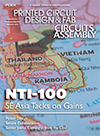New Products
Tridak Model 795 pneumatic dispensing spool valve dispenses high-viscosity fluids, gels, and pastes that require high pressure to achieve suitable material flow. Is for silicone gels, greases, adhesives and sealants. Adjustable flow control ensures accurate and repeatable fluid dispense cycles; adjustable suck-back feature provides clean fluid shutoff. Is designed to operate with fluid pressures up to 2,000 psi.
Tridak, www.tridak.com
Nerlite Hi-Brite machine vision lights include bright LED illumination over large areas. Permit intensity to be increased and focused to provide illumination to the part, even at a distance. Include versatile options, such as multiple sizes and color wavelengths, 10° spot and 50° flood lenses. Feature an integrated controller to quickly adjust light intensity from ultra bright to low light, and operate in continuous or strobe mode; standard industrial M12 connectors, and an industrial IP67 rating for protection against dust, fibers and immersion in liquid. Up to four lights can be connected on one power supply. 24V power standard matches most industrial factory settings.
Microscan, www.microscan.com
The PSD PCB push spacer permits easy access to the underside of the PCB. Sturdy construction supports heavily loaded PCBs. Made from natural color Nylon 6/6; available in UL94 V2 and UL94 V0. Is available in five standoff heights and is RoHS compliant.
Richco, www.richco-inc.com
Siplace WPC (Waffle Pack Changer), for SX placement machines, provides a non-stop supply of component trays. Features a non-stop module that permits the adding of full trays and removal of empty ones without having to interrupt the production flow. Automatically moves new trays to their specified destination in the vertical carrier with 28 positions. Depending on carrier position, trays reportedly can be exchanged in two to three seconds. Eliminates positioning errors of manual systems. Can be combined with Siplace COT30 30-track feeder changeover table.
Siemens Electronics Assembly Systems, www.siplace.com
Differential contactors are customized for each semiconductor test application; contactor materials and probes are optimized for desired impedance. Configurations are derived from 3D electromagnetic simulation software and lab-correlated data; permit experimentation and optimization of the contactor properties. Increasing data rates of semiconductor devices require the test interface from the tester to the DUT be carefully designed to maintain signal integrity. Reduce signal amplitudes, increase speeds, reduce I/O counts and provide improved immunity to external noise; lead to size and power reductions for consumer products such as cellphones and laptops.
Multitest, www.multitest.com
ATS Spray Fluxer is a closed system in which a rotary pump continuously transports flux from the container into a bypass system. For spraying, a bypass valve interrupts the circuit and leads the flux to the spray head. Spray head uses HVLP technology that generates atomization of the flux with a comparatively low pressure; ensures a stable spray jet with a homogeneous spray pattern. Creates considerably less spray mist, reducing soiling in the fluxer area. Both flux quantity and spray pressure are adjustable. All connections are designed as quick-acting closures. Spray head is quickly exchangeable. Flux container is equipped with an additional cover; can be taken out completely. All electrical and pneumatic parts remain in the soldering system.
SEHO Systems GmbH, www.seho.de
Press Releases
- Innominds and SIIX launch SIIX-Innominds JV to offer full-stack ODM services in India
- Syrma SGS Technology, Ltd to Accelerate AI-Driven Manufacturing with implementation of analytics and AI solution from Arch Systems in partnership with NMTronics India
- TTCI and The Training Connection Strengthen Electronics Manufacturing with Test Services and Training at PCB West 2025
- SMTA “Members of Distinction” Awards Announced


